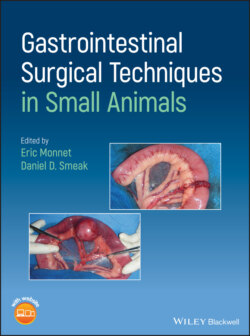Читать книгу Gastrointestinal Surgical Techniques in Small Animals - Группа авторов - Страница 94
5.2.1.1 Passive Drain
ОглавлениеA simple red rubber feeding tube can be used (Figure 5.1). The red rubber feeding tube can be wrapped in a fenestrated Penrose drain to protect the red rubber feeding tube from the omentum.
The patient is placed in right lateral recumbency. After surgically preparing the left caudal abdominal wall, a local block with bupivacaine is performed in the skin and the abdominal wall where the drain is going to be inserted. A bolus of fentanyl can be given to the patient also. The puncture in the abdominal wall is 2–3 cm cranial to the skin incision. A small skin incision is performed with a #15 blade where the local block was performed. A 2–3 cm subcutaneous tunnel is created with a curved Carmalt forceps in a cranial direction toward the local block in the abdominal wall. The tip of the red rubber feeding tube is then grabbed by the curved Carmalt and advanced in the tunnel. The abdominal wall is then punctured with the Carmalt and the red rubber feeding tube. The tube is then advanced in the abdominal cavity.
The red rubber feeding tube is then secured to the skin with a Chinese finger trap with 2‐0 nylon. The tube is then connected to a passive collection system.
If a fenestrated Penrose drain is placed around the red rubber feeding tube it is inserted in a similar fashion than the simple red rubber feeding tube.
